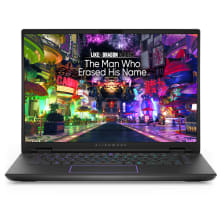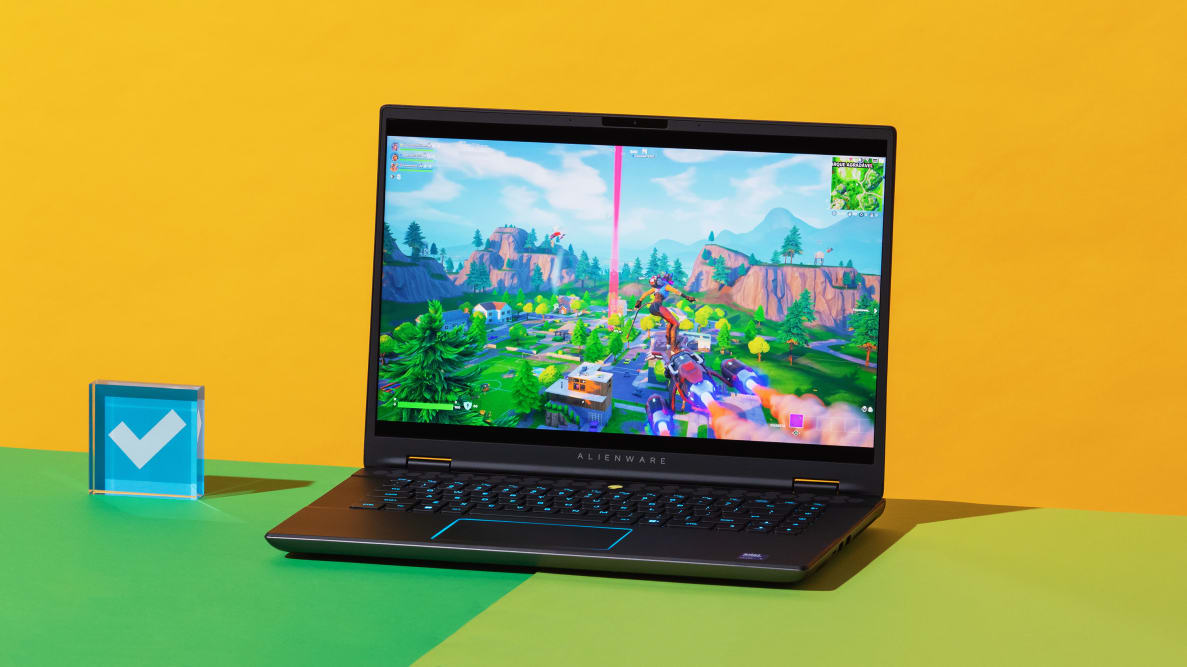Pros
-
Decent specs for the money
-
Strong display for gaming
-
Built well
Cons
-
Underwhelming battery life
-
Whiny fans
About the Alienware m16 R2 (2024)
The Alienware m16 R2’s name may suggest that it’s a simple update of last year’s model, but Dell effectively turned the first m16 into a more portability-minded laptop with the R2. It’s been trimmed down and the rear thermal shelf completely removed.
The Alienware m16 R2 starts at $1,500 and at that price delivers a 16-core, 22-thread Intel Core Ultra 7 155H CPU, mobile Nvidia GeForce RTX 4050, 16GB of DDR5 memory, and 1TB of NVMe storage. That base level also comes with single-zone lighting for the keyboard.
Upgrade options can jump up to an Intel Core Ultra 9 185H with higher clock speeds, an RTX 4060 or 4070, 32GB or 64GB of storage, a variety of storage capacities up to 8TB, per-key RGB lighting, and Windows 11 Pro. Maxed out, the top-tier configuration comes to $3,795.
No matter the configuration, the Alienware m16 R2 comes with the same 16-inch display, a 240Hz, 2560 x 1600, G-Sync compatible IPS panel with 100% coverage of the sRGB color space. Our review configuration costs $1,850 (although it’s currently on sale for $1,550) and comes with just an upgrade to graphics and the keyboard. Curiously, the per-key RGB lighting is less expensive in this configuration than single-zone.
Alienware m16 R2 specs

Dell has slimmed down and refined the m16's design, but kept the glowing alien head logo (you can turn it off).
- Price as configured: $1,850
- Processor: Intel Core Ultra 7 155H (16-core, 22-thread), max speed 4.8 GHz
- Graphics: Nvidia GeForce RTX 4070 8GB (discrete, 140W TGP); Intel Arc graphics (integrated)
- Memory: 16GB DDR5 5600MHz
- Storage: 1TB PCIe gen 4.0 M.2 NVMe SSD, 1 empty 2280 M.2 slot
- Display: 16-inch, 2560 x 1600, 300 nits max (rated); 320.8 nits max (measured), 100% sRGB, 240Hz, IPS, G-Sync, anti-glare
- Ports: 1 x USB-C 3.2 Gen 2 (DisplayPort 1.4), 1 x Thunderbolt 4 (DisplayPort 1.4, 15W power delivery), 2 x USB-A 3.2 Gen 1, 1 x microSD card reader, 1 x 3.5mm audio combo jack, 1 x HDMI 2.1, 1 x RJ-45 2.5Gb Ethernet, DC Power
- Connectivity: Wi-Fi 7, Bluetooth 5.4
- Battery: 6-cell Li-ion 90Whr
- Weight: 5.47 pounds (2.48 kilograms)
- Dimensions: 14.33 x 9.82 x 0.93 inches
- Special features: Windows Hello FHD webcam, variable refresh rate, camera security switch, 1080p webcam, per-key RGB keyboard backlighting, trackpad edge lighting, Dolby Vision and Dolby Atmos certified
- Warranty: 1-year courier or carry-in
What we like
The respectable value

Although not the fastest overall, the m16 R2 might be the least expensive way to get a mobile RTX 4070 when it goes on sale.
The Alienware m16 R2 isn’t the most powerful laptop we’ve tested, but it puts on a good show for a sub-$2,000 gaming laptop. It ranks among the top 10 performers in many of our benchmarks and is always in the top 20.
The CPU and GPU pairing on display here easily deliver high frame rates at 1080p or 1200p. In Far Cry 6 and Shadow of the Tomb Raider, it readily averages over 100 frames per second (fps) with the highest graphics settings at 1920 x 1200; the display has a 16:10 aspect ratio, after all. It even runs Cyberpunk 2077 at ultra settings without ray tracing at an average of 76 fps.
Bumping up to the display’s native 2560 x 1600 is a little too much for the system without upscaling, and performance drops below the 60fps mark except in older games like Far Cry 6 and Shadow of the Tomb Raider. When ray-tracing is enabled the system can stumble a little, but if you’re willing to let DLSS do its thing, you can easily claw back those frames.
Beyond that, the Alienware m16 R2 offers one of the fastest SSDs we’ve seen in a gaming laptop and it’s helpful to have a base of 1TB of storage for big game libraries. It rounds out an altogether decent build that we’ll dive into more later.
The base specification at $1,500 isn’t the most appealing, as the RTX 4050 comes up lacking in a lot of games. But the RTX 4060 configuration for $1,600 is a decent value, and it’s a $300 jump to the RTX 4070 in our review unit. Dell fits a lot within those price tags, and it’s quite reasonable, especially during sales when higher-tier units can cost as little as the base configuration.
Memory and storage are user-expandable
What really pushes a good laptop into great territory is the ability to carry it into the future. They are never as upgradeable as desktop PCs, but having access to memory slots and storage upgrades is big, and the Alienware m16 R2 offers both.
As mentioned, the included SSD is fantastic, so we don’t see much reason to swap it out. Thankfully, you don’t have to. There’s a second M.2 slot inside that will let you install a second SSD. This perk also improves value, since you can wait to make these upgrades until you need them. Because storage and memory prices tend to decline as time goes on, storage and memory upgrades a year or two from now should be cheaper than adding them today.
The subtle, comfortable design
Dell’s efforts to shrink the Alienware m16 R2 worked out well. It’s a stealthy machine that avoids the jutting rear end of Dell’s past Alienware gaming laptops while keeping the extra ports that most competitors fit onto the rear.
The laptop measures a little under an inch thick, though the rubber feet that wrap around the base bump it closer to 1.15 inches and could pose some issues for tighter laptop sleeves. It still ends up fairly easy to slip into bags that accommodate other 15 or 16-inch thin-and-light laptops.
Just mind the weight, as it is still nearly 5.5 pounds. While this size is modest for an older gaming laptop, plenty of competitors are driving ever thinner, with systems like the similarly configured 4.3-pound 2024 Asus ROG Zephyrus G16 (only 0.65 inches thick), which makes the Alienware look huge by comparison. Of course, that thin design comes with some trade-offs to performance. The Alienware M16 R2 running at 1200p was able to keep pace with the Zephyrus G16 running at a lower 1080p resolution.
The sleekness of the design is well accentuated by the aluminum wrapping the top and bottom of the chassis. But perhaps a more pleasant element is the Soft Touch-like coating to the keyboard deck and palm rest, which feels gentle and has a subtle glitter embedded in the otherwise matte black finish. Dell also avoids a sharp edge at the front of the palm area, which is great for wrist comfort.
While there are still alien head logos and a slightly eye-catching honeycomb pattern for ventilation, the Alienware m16 R2 is altogether subdued considering it comes from a brand that started out making some of the most ostentatious PCs around.
Of course, when it’s time to go all out, the RGB keyboard lighting shines bright, the Alienware logo on the lid lights up, and even the trackpad has perimeter lighting.
It has a respectable display for gaming

It isn't an OLED display, but the m16 R2's panel is quick and has good color accuracy.
I’ve seen plenty of laptops offer abysmal displays in the pursuit of lowering the price. Dell avoids that with the Alienware m16 R2. It’s not the most amazing I’ve seen, with that honor tending to go to OLED options (and there are plenty this year), and its Dolby Vision certification may suggest a visual quality that it is far from achieving especially when it lacks HDR support, but it’s up to the task for most games.
The 16-inch panel is wonderfully sharp at 2560 x 1600, and it’s flanked by fairly narrow bezels that keep it from looking too dated. That display runs at a speedy 240Hz and has a low pixel response time to keep fast-moving objects smearing across the screen.
Color accuracy and gamut are also respectable. The Alienware m16 R2 display covers 100% of the sRGB color space, giving content a fair bit of color. It’s a long way from full DCI-P3 coverage, but some cheaper displays offer less than 70% of the sRGB color space, which leaves visuals feeling drab.
You won’t want to be gaming outside, though, as the brightness maxes out at just over 320 nits. The anti-glare finish helps with visibility despite the limited brightness but dark content will still be hard to see. When indoors, visibility is quite good.
The display pairs with decent speakers. They aren’t incredibly loud and can sound a bit boxed in, but are fuller and offer more low-end than most other laptop speakers. They nicely complement the display while gaming or watching media without needing extra gear.
The keyboard feels great

The keyboard is surprisingly good for a gaming laptop.
The Alienware m16 R2 includes a solid keyboard. The keys have a wonderful tactility, offering a decent resistance that requires some intention behind each key press while keeping the keycaps stable and resetting them quickly for repeated presses. This makes for comfortable gaming and typing.
I managed to score a typing speed of 120 words per minute in the Monkeytype typing test with 99% accuracy after only a short while using the keyboard, which is about as high as I can get on all but truly exceptional keyboards.
There are downsides, such as the arrow key arrangement—which sees the up arrow cut into the space of the right shift key—and the lack of a numpad despite this being a 16-inch laptop. These small sins are easier to overlook when the typing experience is on the high end for laptop keyboards. Dell at least includes a column of volume keys on the right-hand edge.
What we don’t like
The fans are whiny

You can expect noticeable noise while Performance or Overdrive modes is activated.
Gaming systems need powerful fans to keep their internals running optimally, but the slimmer design of the Alienware m16 R2 may have forced Dell to go with fans that need to work even harder. The resultant fans emit a fairly high-pitch whistling even when they’re not under a heavy load. Beyond the whistling, they don’t sound too bad—coming across like a strong breeze more than a jet engine—but the whistling cuts through.
This is even more noticeable when running the Performance or Overdrive modes through the Alienware Command Center that net the system its fastest speeds. The fans are hushed in Balanced and Quiet mode. The F2 key engages a Stealth Mode by default that turns off all the RGB effects and switches to the Quiet profile.
When it’s time to game, the Quiet profile won’t net anywhere close to the most performance and thus the noisy Performance or Overdrive profiles will be all but necessary.
Battery life is lacking
Gaming laptops have mostly gotten their act together, figuring out how to tame the beast inside when they’re not gaming and, in turn, offer a reasonable battery life.
We’ve tested a few that have lasted over 11 hours, such as the Asus ROG Zephyrus G14 and HP Victus 16, and several more that meet the critical 8-hour-plus mark that makes them well suited to productivity during the workday. But the Alienware m16 R2 isn’t one of these.
In our battery test, which involves rotating through a set of Google Chrome tabs with the display set to 200 nits until the laptop dies, it barely scraped out just 4 hours of runtime. That’s with the discrete GPU disabled and performance set to the most efficient profile.
One penalty the Alienware m16 R2 suffers from is its resolution. All other things being equal, a higher-resolution display will be a bigger drain on the battery as the system has to draw more pixels. It also has a high refresh rate at 240Hz, and that’s an even bigger energy sink that Dell hasn’t set to automatically adjust for power savings when running on battery. Dropping the display to a 60Hz refresh rate saw the system come up one minute shy of a 5-hour runtime.
Dell also has an interesting take on battery operation that I haven’t seen from other brands. The system allows for Overdrive mode—the highest performance profile—even when operating on battery power. That could be useful in some scenarios, but probably won’t matter for most people as it will drain the battery in record time.
Should you buy the Alienware m16 R2 (2024)?

The Alienware m16 R2 is a great laptop for gamers on a budget who might not care as much about battery life.
Maybe, if you’re comfortable trading battery life for performance
The Alienware m16 R2 is a well-built, high-performance machine that competes on price and specs with other great gaming laptops. Its display is geared up for quality gaming and it boasts an array of ports that make it easy to set up at a desk. Windows Hello facial recognition pairs well with a decent webcam, and a great keyboard rounds out the whole package.
Performance often comes with a cost, however, and in this case those costs are noise and battery life. The Alienware m16 R2 may be able to keep up with some of its contemporaries in speed, but it can get pretty whiny. Even when the performance is dialed back considerably it can struggle to match the stellar battery life of options like the HP Victus 16 (2022) or Acer Nitro 16 (2023). And it’s certainly no match for the portability of the 2024 Asus ROG Zephyrus G16 or 2024 HP OMEN Transcend 16.
For a slim and performant system that will spend most of its time plugged in (but still fits in a bag from time to time), the Alienware m16 R2 does the job. But there are better rounded options if you regularly work on the go.

The Alienware m16 R2 wins on performance and value, but its 5-hour battery life is a bit lacking.
Meet the tester

Mark Knapp
Contributor
Mark Knapp has covered tech for most of the past decade, keeping readers up to speed on the latest developments and going hands-on with everything from phones and computers to e-bikes and drones to separate the marketing from the reality. Catch him on Twitter at @Techn0Mark or on Reviewed, IGN, TechRadar, T3, PCMag, and Business Insider.
Checking our work.
Our team is here to help you buy the best stuff and love what you own. Our writers, editors, and experts obsess over the products we cover to make sure you're confident and satisfied. Have a different opinion about something we recommend? Email us and we'll compare notes.
Shoot us an email



